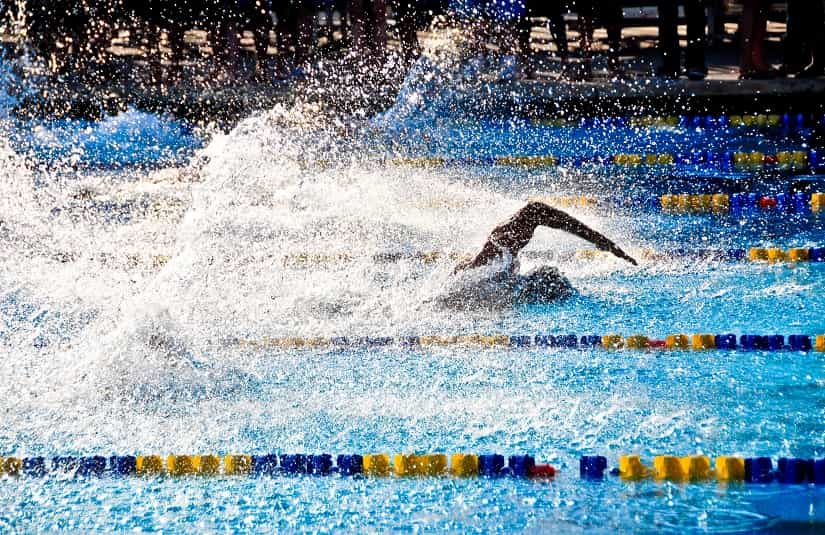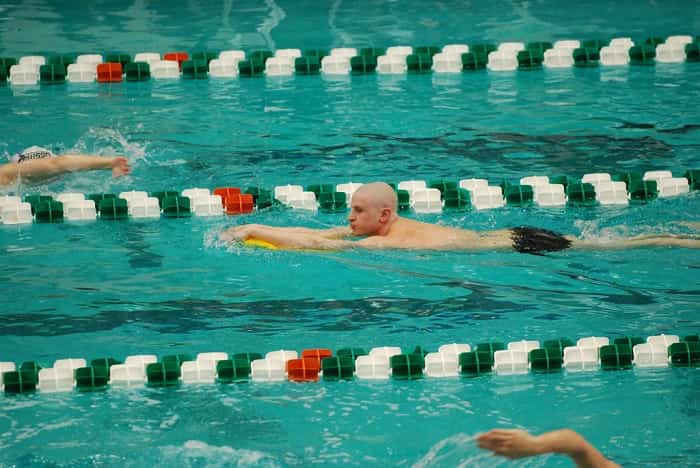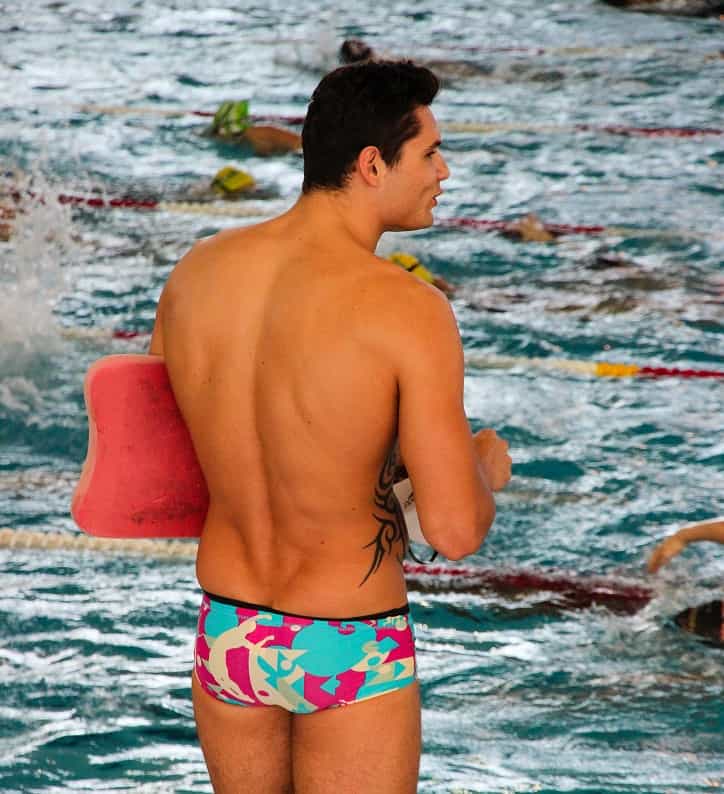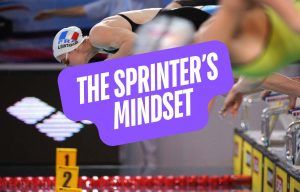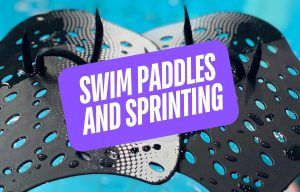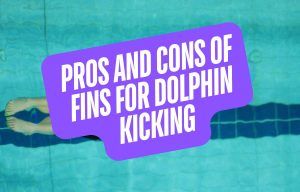In a world of ever-more specialized swimming equipment the kickboard has lost a lot of its luster. Here is why I will never give up my kickboard.
The swimmer’s kickboard has been poolside for decades, as ubiquitous to the experience and training of a competitive swimmer as the smell of chlorine and swimsuit tans.
But as the swimmer’s gear bag has grown with the addition of snorkels, tempo timers, parachutes and more over the years, the kickboard has lost its dominant position on the wall at the end of the lane.
I’m here to tell you that I love my old, green Tombstone kickboard.
It’s old, it’s ugly, and it can float my big butt up and down the length of the pool. It’s large enough that my hips stay high enough in the water, and recently after a few weeks of doing heaps of high intensity kick work on the board I dropped a couple seconds on my 50-free kick for time.
SEE ALSO: The 9 Best Kickboards for Swimmers
So for me, the kickboard is a no-brainer. But for others, maybe not so much.
Over the past few years the kickboard has been blamed for a variety of swimming dysfunctions, from poor body alignment, poor head position, and more.
But I am going to keep that ugly piece of space plastic at the end my lane each day at swim practice.
Here’s why.
The Kickboard: A Super, Duper Training Aid
What follows is a list of reasons why I love the kickboard, and yes, even some reasons to loathe it.
As I will try to emphasize over the course of listing the arguments for and against, whether you use the board should ultimately come down to what you are trying to accomplish in the water.
1. You can exclusively target your legs.
This is the whole point of using a kickboard, right? Right. Launching yourself into a kick set with a board will increase overall fitness and speed capabilities of your kick, regardless of your specialty.
Having strong legs goes beyond having a fast kick; good leg conditioning means your stroke stays together longer, and helps you finish races strong.
With the kickboard it is harder to cheat using your arms, as I see many swimmers do when they are tasked with kicking on their sides or on their back.
2. Gives your shoulders a break*.
By focusing exclusively on your lower body your shoulders get a nice little time-out.
The pulling motion is the main propulsive force in most of the strokes (breaststroke kick being the exception), and as a result they get a heckuva thrashing over the course of your swim workout.
Beaching yourself on a kickboard gives your shoulders a time-out.
(Sort of, and I will explain shortly how this isn’t always a good thing.)
3. Promotes a high hip position*.
Although some coaches will tell you that using a kickboard promotes bad body positioning (from head to shoulder to hips), this isn’t always true. In my experience when swimmers use the board properly their hips are actually high up in the water.
If you use it with the bottom of the board in your arm pits a high hip position isn’t hard to achieve. If you kick with arms completely outstretched, your hands clasping the bottom of the board of course your hips will plummet to the bottom of the pool. Or if you stick your head up as high as you can like a periscope then yes, your hips will inevitably sinkitty-sink.
Focused, mindful kicking means that your hips are high in the water—it’s not always that the board creates poor hip positioning, it’s the swimmer not paying attention to their hips that creates poor hip placement.
4. Flat hips (good for sprinters).
Sprint swimmers don’t roll their hips as much as their mid-distance and distance brethren. Kicking with a board is close but not identical to the hip position that happens during sprint freestyle swimming where a bulk of the rotation comes from the shoulders.
5. Oxygen for days.
Swimming is one of the few sports I can think of that restricts your breathing. Unlike most athletic endeavors, your opportunities to drink down some of that sweet, sweet oxygen is limited to your breathing pattern in the water.
When you are using a kickboard you can breathe freely. With no pesky breathing patterns, underwaters, flip-turns or even push-offs to limit oxygen intake you can go to work at a harder pace. How? Because you are able to gulp down as many breaths as possible your muscles are fed a steady diet of oxygen to keep your legs grinding.
So yeah, there’s that extra breathing thing which I can appreciate.
6. Works well for breaststrokers.
The added flotation is ideal for improving the breaststroke kick as it simulates the natural swimming position of the stroke. A fast breaststroke comes with having a high and strong chest during the pulling motion, and the kickboard comes close to simulating this.
7. Easier to learn proper kick mechanics.
This point is more for beginner swimmers.
Learning proper kicking motion is hard (something most of us competitive swimmers forget after a while), and is a whole lot easier when you don’t have to worry about keeping yourself afloat to master the mechanics of it.
Having your head above water also means you can hear better hear the yelling, err, instruction from your pool-side coaches and instructors.
8. You can see your splits.
If you’ve ever trained in a dark pool you know the struggle that comes with trying to see accurate splits during your sets, especially if you got one of the 4-handed pace clocks and not a digital clock.
Being mounted up on a board means you can see with better precision, which comes in handy during test sets and high intensity efforts.
*
Of course, some, if not most, of these things are entirely possible without a kickboard. I could have easily put an asterisk beside each and every one of them.
You could just as easily do kicking with your arms at your side with a swimmer’s snorkel, for instance. Or head over to the deep end of the pool and do some vertical kicking.
The Kickboard: The Ugly
Which brings me to the limitations of the kickboard:
1. No hip roll.
You’d be surprised how much power and velocity originates from your hips in your swimming. The arm recovery and hand entry is powered by your hips. With your hips flat it is hard to replicate and power up the hip movement of the stroke.
Kicking flat on a board will isolate the kicking motion, but at the expense of the hip roll.
2. It sucks when your shoulder is banged up.
Although intuitively the kickboard should be the first thing you reach for when your shoulder eats it, research shows that using a kickboard tends to cause further irritation in athletes who are suffering from swimmer’s shoulder.
Which makes sense–if you are having impingement issues in your shoulder(s) having them both above your head for long kick sets is unlikely to help put out the the fire in your shoulder.
A couple months ago I strained my right bicep tendon in the gym—using a kickboard while it was healing was agony. For a week I had to set aside the big green Tombstone and employ a variety of board-less kick work.
3. Extended bouts of kick with a board will make your neck seize up.
If you are sitting while reading this look straight up (go on, no one will judge ya). Now imagine holding that position for 10, 15 minutes or longer.
- Related: Looking for the top kickboards on the market for children? Here’s a detailed look at the best swim kickboards for children and toddlers.
Ouchie, right? It’s a super unnatural way to place your head, especially for a long duration of time.
Kickboards usually don’t promote a good head position, and this neck-seizing is especially prominent when you maintain proper body position in the water while kicking–the higher your hips, the more you are craning your neck.
4. Not always the best for dolphin kicking.
With the proliferation of the dolphin kick across all four strokes the need to train it has become ever more critical. Beyond doing them off the walls in practice, fliers in particular will log in some time doing specialized kick work on a board.
Russell Mark, in our flagship underwater dolphin kick guide notes that some movement in the upper body during the kicking motion is okay. Some swimmers excel with this kind of “bouncy” upper body-led underwater (Caeleb Dressel’s underwaters comes to mind), while other underwater specialists keep a very still and un-bouncy upper body when fly kicking (Michael Phelps underwater dolphin kick is a great example of this).
Undulation is necessary for a powerful fly kick, and the use of a kickboard can restrict the body’s natural suppleness, sometimes leading to lower back pain. A dolphin kick that is initiated from the hands is really hard to replicate using a kickboard without pointlessly bouncing the board up and down across the surface of the water.
Although I love my ugly green kickboard I have found that it is not as effective for working my underwater fly kick. (Here is a better way to train your underwaters.)
How to Successfully Use a Kickboard In Your Training
So you’ve heard the good, and you’ve heard the bad. Now here are some tips for making better use of your board:
1. Mix up the way you are kicking.
If you are worried that your head and hip habits will show themselves in your swimming, mix it up. There is no *best* way to get your kicking work in, just the best form of kicking that suits you and your goals.
For a better fly kick doing fish kicks are a great way to improve undulation and balance out your kick. For swimmers with shoddy body rotation going face down with a snorkel and rotating your shoulders out of the water one at a time can be profoundly helpful.
Do the kick work that is specific to what you want to improve in the water.
Mindless kicking is fun if you want a good workout (I guess…), but mindful and targeted kicking—regardless of whether you use a kickboard—should help you become a better swimmer in some way.
2. Combine a board and a snorkel.
I talked earlier about how the swimmer’s mesh bag has exploded over in the past decade. Take advantage of some of that new gear by adding a snorkel to your kick work and give your neck a much-needed break.
Having your face down in the water encourages better head position, and relieves the neck tightness and cramping that comes with having your head up.
3. Spice up the kickboard work.
The kickboard doesn’t need to be used solely as a device to mount yourself on and kick your little feet off.
Backstrokers can use it to help reduce to much knee bend in their kick by placing it over their knees while kicking on their back. Or you could extend the board ahead of you in a vertical position to add a ton of resistance and difficulty to your kicking (we called this “snow-plow kicking”–how Canadian is that!).
Whatever it is that you want to improve with your swimming and your kick, there is a way to use the kickboard to help get you there, so don’t limit yourself to the standard form of using the board.
The Takeaway
Swimming equipment and gear are always changing, even though the goals and outcomes that we hope to achieve with them remain the same: swimming faster with better technique.
Having a stronger kick will help you become a better swimmer overall, but the means you take to get to improving your kick can be as varied as you are.
Which means that for me, I will keep on kickin’ on with my ugly green kickboard.
More Kicking Resources
If you have been to this site before you know how much I talk about the importance of improving your kick. Whatever your specialty if you want a better kick I got ya covered with the following guides and sets:
How to Improve Your Breaststroke Kick with Two-Time Olympian Mike Alexandrov. Here are three breaststroke kicking drills from NCAA champion and Olympian Mike Alexandrov that will help you power up your breaststroke kick (with video demonstrations).
How to Develop an Unstoppable Freestyle Kick. Research, sets and technical tips on how to unleash a vicious flutter or freestyle kick.
How to Develop an Awesome Underwater Dolphin Kick. This guide features tips and pointers from Olympic butterfly champions, elite coaches, biomechanists and even a rocket scientist (seriously).
All the Kick Sets You Could Ever Want. Our ever-growing list of kick sets and swim workouts. Features sets and practices from Olympians, NCAA champions, and Olympic coaches.

